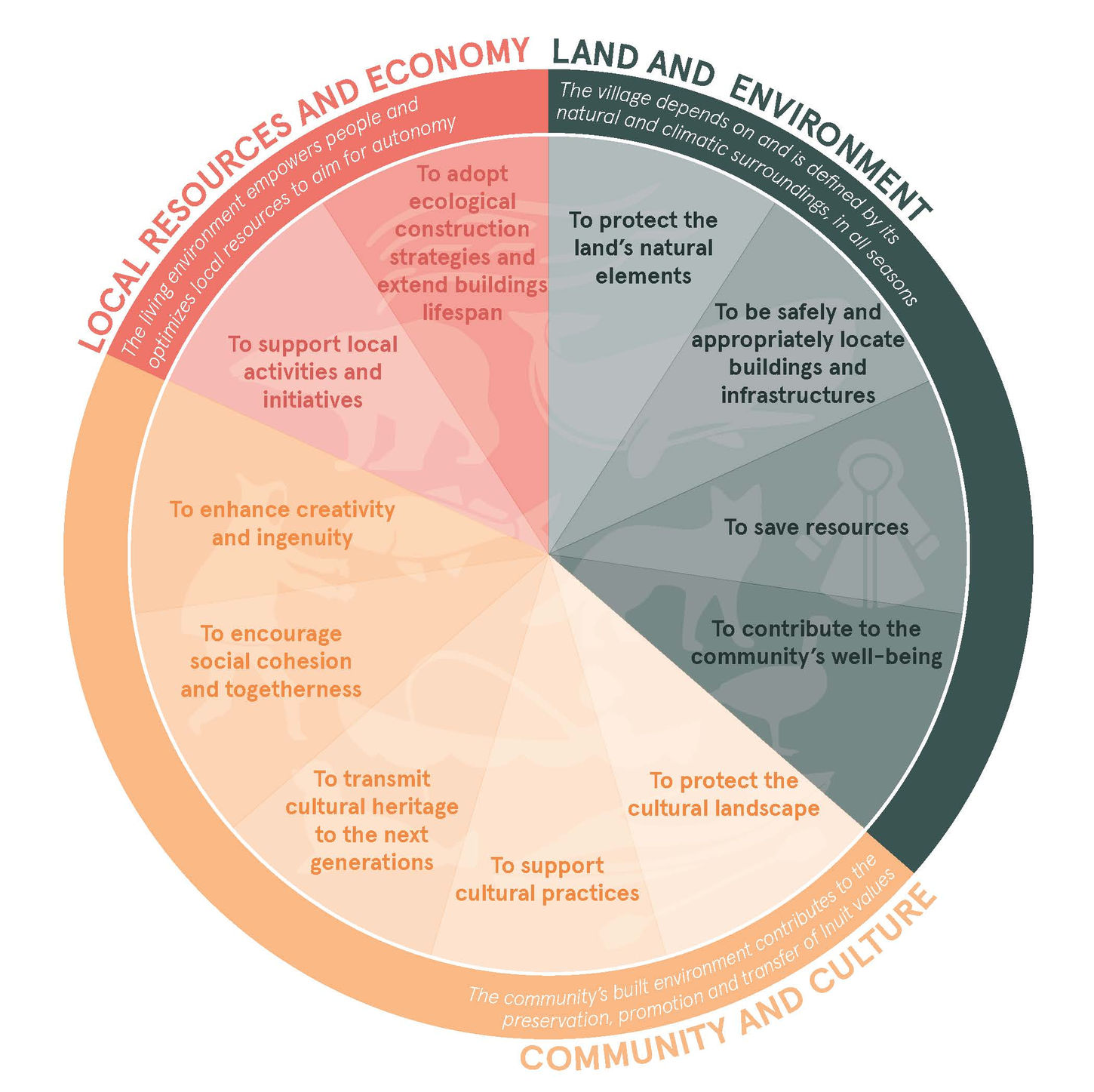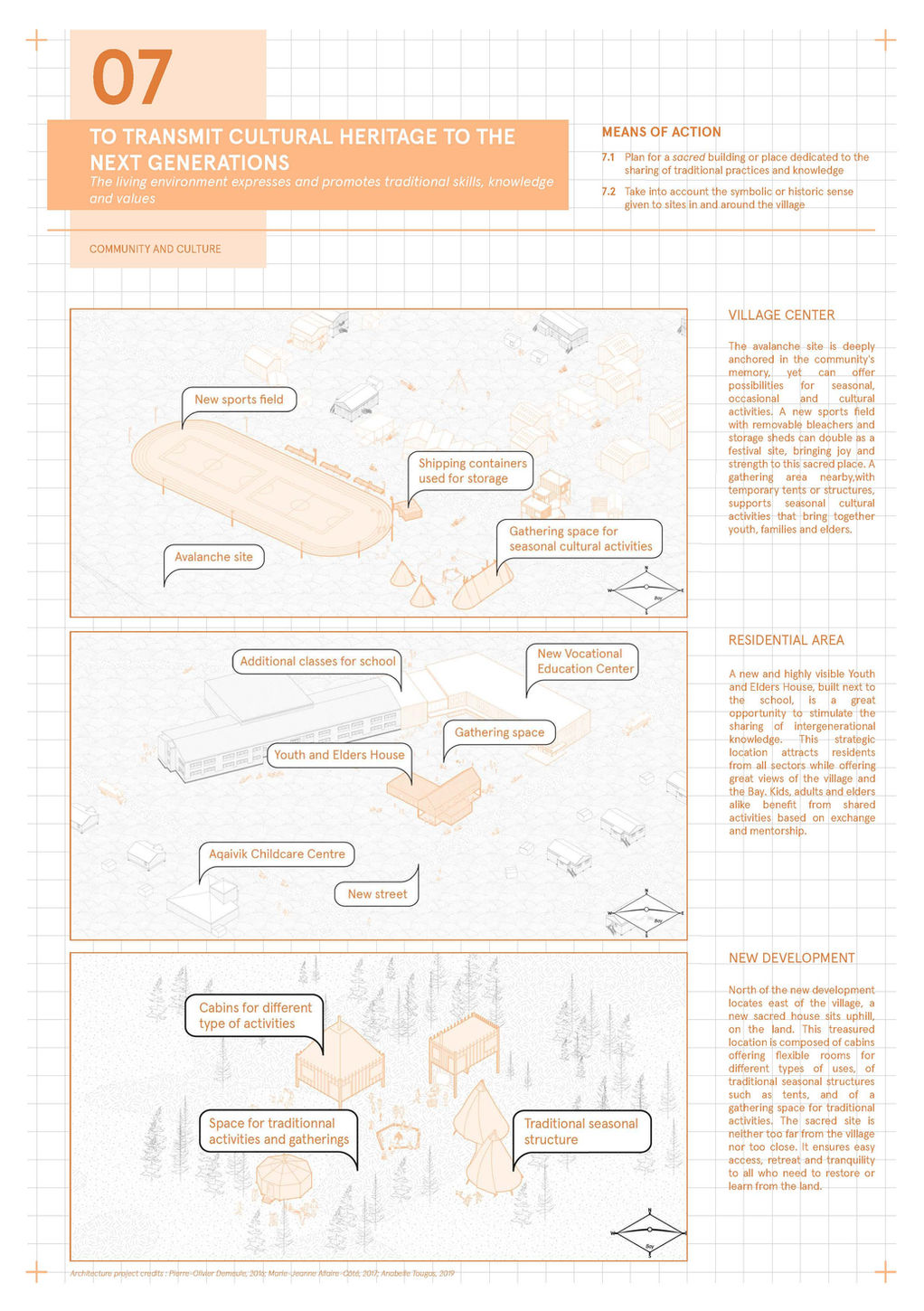

Hilda Snowball
Visions for the future: towards truly Northern living environments (2019)
"How can we indigenize the policies that we are facing in our communities? How can we indigenize the requirements that are made, for example the building codes? How can we have an input - our own Inuit ways? Because Inuit have knowledge as well."
The complexity of Nunavik’s housing production system, combined with the short timeframe for materials delivery and building, make it hard for communities and decision makers to rethink village planning. The limited human and financial resources, the existing housing and development frameworks, and the multiplication of instances in charge make it less appealing for locals to get involved in the process and have their say through bottom-up initiatives to initiate change. Although open to such change, the planning instances maintain their current ways borrowed from the South. These ways include masterplans that appear to be driven more by infrastructure and zoning than by local resources and economy, land and environment, community and culture. How then can village planning be done the Inuit way?
What We've Learned
Realities
Paths for Change
Indigenous planning is a concept shared by nations around the globe and refers to the local and intuitive ways of production of vernacular settlements. It relies on a place-based approach in which settlement strategies are directly linked to the context and realities of each community and their land. It counts on both contemporary and traditional knowledge to reveal the inseparable relationships between places, people, ancestors, and other living beings. Indigenous planning principles and approaches align with Nunavik’s evolving structures and lead to planning strategies that are guided more by self-determination than by colonization.
Indigenous planning is not only a process but also an outcome that can empower communities through collaboration. In accordance with Two-Eyed Seeing principles, its strategies recognize the co-existence of two planning entities—“State” and “Inuit”. This approach can lead to a rethinking of local practices and regulations to better adapt planning tools and innovate. Masterplans and zoning by-laws tend to hinder local involvement and resist “outside the box thinking”. Innovative approaches should rely on flexibility to allow for future transformation through scenarios, which can illustrate resilient development rather than standard regulations, particularly in the face of demographic and climate changes.
Moreover, the 7th Generation concept can guide sustainable planning principles: the knowledge of the past informs that of the present, which together build a vision for the future.
Calls to Action

1. Involve the community
Give Nunavimmiut the central voice in the planning of village expansions or transformations.
Foster community-driven approaches to decision making and planning, such as the Parnasimautik consultation.
Put forth collaborative design processes.

2. Make way for local knowledge
Place traditional ecological knowledge (TEK) at the heart of decision-making processes.
Adopt decolonized planning methods and rely on actual context-based approaches grounded in Inuit ways of thinking, doing, and being.

3. Plan with the past, present and future in mind
Look to the 7th Generation when making decisions today: remember the legacy while considering the impact on future generations.

4. Create and implement flexible planning tools and processes
Think outside the “functionalist” toolbox.
Develop innovative decision-making tools and planning methods that support community resilience: form-based codes, locally-grounded scenarios that allow for flexibility, collaborative design, decision-making committees involving NV and Landholding representatives, etc.
Pinasuqatigiitsuta, this guide’s name, means “working together for the common good”. This online collaborative decision-making tool supports the sustainable and resilient planning of tomorrow’s Northern Villages—for Inuit, by Inuit.
This innovative guide focuses on the desirable qualities for sustainable Inuit living environments rather than current land-use planning approaches. It proposes a cyclical process of iterative steps that center on local assets and perspectives, as well as on flexibility.
The guide highlights 11 community planning principles that apply to three areas of interest: land and environment, community and culture, local resources and economy. Each principle is further explained with illustrated scenarios for change, applicable in different areas of a typical Nunavik village (with Kangiqsualujjuaq as an example). A step-by-step guideline to implement the scenarios ensures that community goals are aligned with Inuit way of life and desirable futures.
By M. Bayle, A. Paquet and F. Trottier, École d’architecture de l’Université Laval, 2020
A Guide for Flexible and Resilient Community Planning for and by Inuit
Innovations: Thinking Outside the Box
Outside the Box Innovations
References
Open Access
Allard, M, Deslauriers, C, & Gauthier, S (2020) Planning Northern Villages expansion: Nunavik, https://storymaps.arcgis.com/stories/972ec51ef8134e9eafe6db4c35551169
Bayle, M, Paquet, A, Trottier, M (2019) Pinasuqatigiitsuta : A guideline for community planning in Nunavik. Web planning tool. Projet de fin d’études en design urbain, Université Laval. https://www.pinasuqatigiitsuta.org/
Bayle, M, Paquet, A, Trottier, M (2019) Pinasuqatigiitsuta : Working together for the common good. Présentation vidéo. Habiter le Nord québécois, U. Laval, Québec. https://www.youtube.com/watch?v=ClE6pW3_Ep4
Breton, MP & Cloutier G (2017) Cadre institutionnel et pratiques locales de l'aménagement en territoire nordique : un dialogue en trois temps illustré par le cas de Kuujjuaq. Recherches amérindiennes au Québec, 47 (1) : 87–99. https://doi.org/10.7202/1042901ar
Dalla Costa, W (2021) Design as ceremony. Indigenous Futurities, Designing for Resilience. Global Perspectives (winter edition), Pan-Canada Lecture Series 20-21, March 10th. https://www.youtube.com/watch?v=o_wAcnZOZV0
Desbiens, C (2012) 10 idées pour le Nord : un manifeste pour la nordicité. Cahiers de géographie du Québec 56 (159). https://doi.org/10.7202/1015311ar
Desbiens, C. & Hirt, I. (2012). Les Autochtones au Canada : espaces et peuples en mutation. Information géographique, 76(4), 29-46. https://doi.org/10.3917/lig.764.0029
Dybbroe, S. (2008). Is the Arctic Really Urbanizing? Études/ Inuit/Studies 32 (1) : 13-32. https://doi-org.acces.bibl.ulaval.ca/10.7202/029817ar
Landry, J (2018) Sédentarisation au Nunavik: Identités, territorialités et territoires Inuit contemporains. Essai en design urbain, Université Laval, Québec. https://www.bibl.ulaval.ca/doelec/TravauxEtudiants/a2862486.pdf
McDonald, MP & Snowball, H (2019). The Fragile Resilience of the North. Landscapes + Paysages, Spring 21 (1): 50-52. https://www.csla-aapc.ca/sites/csla-aapc.ca/files/LP%2B%20Spring%202019.pdf
Parnasimautik (2015) Rapport de la consultation Parnasimautik réalisée auprès des Inuits du Nunavik en 2013. Novembre. https://parnasimautik.com/wp-content/uploads/2015/03/Parnasimautik-consultation-rapport-fr.pdf
Sioui, C, Guimont Marceau, S (2023) Le design participatif : un outil pour visibiliser les récits autochtones dans le paysage urbain. Urbanité, numéro spécial Adopter une vision renouvelée du territoire, printemps été, pp 17-19. https://ouq.qc.ca/wp-content/uploads/2023/05/urbanite-printemps-ete-2023.pdf
Snowball, H and McDonald, M-P (2020) Protecting Nunavik’s Cultural Landscape, Revue ARQ Architecture and design Québec, 190 : 11-15. https://issuu.com/hlnq.linq/docs/arq190-habiterlenord
Trottier, F (2022) Résilience, urbanité et Relationalité : Qualités urbaines et principes d’aménagement fondés sur une approche de planification autochtone durable et inclusive. Essai en design urbain, Université Laval.
Sheppard, L (2020). Nunavut Urban Futures: Vernaculars, Informality and Tactics (Research Note). Études Inuit Studies, 44(1-2), 323–347. https://doi.org/10.7202/1081808ar
McDonald, M-P, Snowball, H (2019). The Fragile Resilience of the North. Landscapes + Paysages, Spring 21 (1) : 50-52. https://www.csla-aapc.ca/sites/csla-aapc.ca/files/LP%2B%20Spring%202019.pdf
Vachon, G, Avarello, M, Landry, J, St-Jean, L (2021) Territorialities and Urbanities Transform: A Scenario-Based Approach to Local Planning and Decision Making in Inukjuak and Salluit, Nunavik, Études Inuit Studies 44 (1-2), pp. 207-236. https://doi.org/10.7202/1081803ar
Other
Hemmersam, P (2021) Making the Arctic City: the history and future of urbanism in the circumpolar North. London: Bloomsbury (e-book). https://www.bloomsbury.com/ca/making-the-arctic-city-9781350235861/
Matunga, H (2013) Theorizing Indigenous planning. In D. C. Natcher, R. C. Walker, &
T. S. Jojola (eds.) Reclaiming Indigenous planning (pp. 3–32). McGill-Queen’s University Press. https://www.mqup.ca/reclaiming-indigenous-planning-products-9780773541948.php
Nungak, Z (2016) Inventing Arctic Town Planning: Commentaries. Collection of radio commentaries, unpublished
















